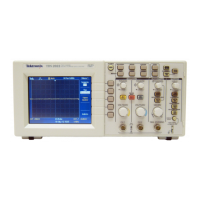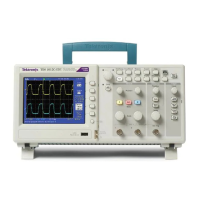Command Groups
2−30
TDS200/1000/2000 Series Oscilloscope Programmer Manual
When DATa:WIDth is set to two:
H If sending data, the oscilloscope mulitplies each point by 256; the
most significant byte then has meaningful data and the least
significant byte is 0
H If receiving data, the oscilloscope truncates the data (divides by
256) and saves the most significant byte
NOTE . The oscilloscopes uses these methods to handle waveforms
transmitted in ASCII or binary format.
The oscilloscope can transfer waveform data in either ASCII or
binary format. Use the DATa:ENCdg command to specify one of the
following formats:
H ASCII data is represented by signed integer values. The range of
values depends on the byte width specified. One-byte-wide data
ranges from –128 to 127. Two-byte-wide data ranges from
–32768 to 32767.
Each data value requires two to seven characters. This includes
one character for the minus sign if the value is negative, one to
five ASCII characters for the waveform value, and a comma to
separate data points.
An example of an ASCII waveform data string follows:
CURVE<space>–110,–109,–110,–110,–109,–107,–109,–107,
–106,–105,–103,–100,–97,–90,–84,–80
H Binary data can be represented by signed integer or positive
integer values. The range of the values depends on the byte width
specified.
Table 2-22 lists the ranges for one- and two-byte-wide data.

